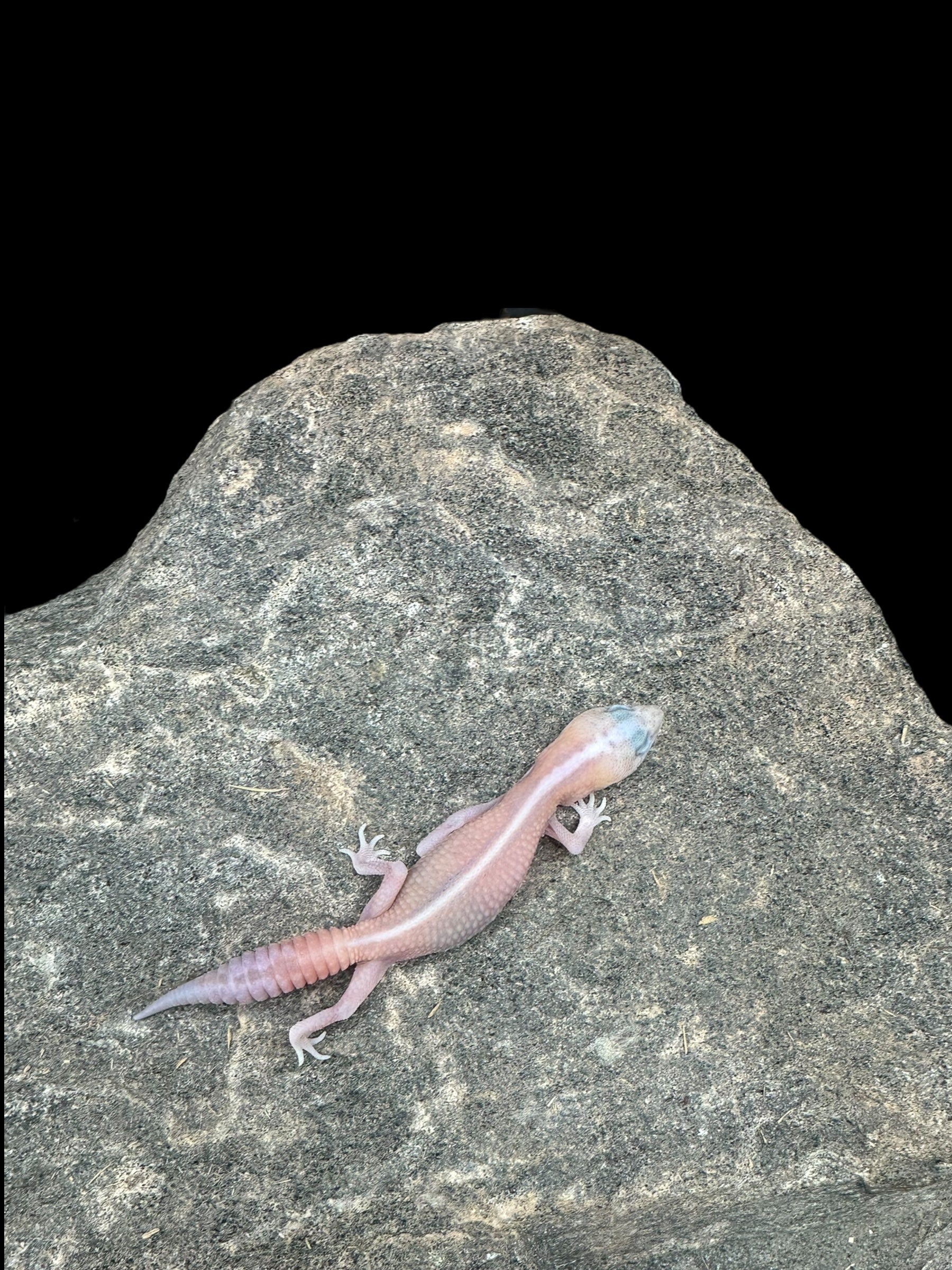Photo Disclaimer
Description
African Fat Tail Gecko (Striped Patternless Zulu Ghost poss. het. Oreo)
Scientific Name: Hemitheconyx caudicinctus
Common Name: African Fat Tail Gecko
Species Overview
Size: Adult African Fat Tail Geckos typically reach 7–8 inches (18–20 cm) in length, with males being slightly larger and heavier-bodied. Their thick tails serve as nutrient reserves, supporting hydration and health during periods of reduced feeding.
Appearance: The Striped Patternless Zulu Ghost poss. het. Oreo African Fat Tail Gecko is a stunning combination morph that blends multiple recessive traits to produce a highly unique appearance. The Patternless gene removes most body markings, the Zulu gene influences undertone and head patterning, the Ghost gene reduces melanin to create a soft, washed-out look, and the Stripe gene adds a faint dorsal line or tonal ridge down the back. The result is a pale, misted gecko with smooth gradients of grey, beige, or creamy white, often with a faint stripe barely visible under certain lighting. Because this individual is a possible het. Oreo, it may carry a hidden dark-pigment gene that can intensify future breeding outcomes.
Distribution: Native to West Africa, including Senegal, Ghana, Togo, Benin, and Nigeria, where the species thrives in dry savannas, rocky hillsides, and grasslands.
Habitat: In the wild, African Fat Tail Geckos occupy burrows or shaded rocky shelters to avoid extreme daytime heat. In captivity, they flourish in naturalistic terrariums with compacted soil-sand substrates, moderate humidity, and multiple hides for temperature regulation and security.
Behaviour: These geckos are nocturnal, gentle, and calm in temperament. Their slow movements and tolerance of handling make them well-suited for display and advanced breeding collections.
Captive Care
Enclosure: Provide an adult enclosure at least 24 inches × 18 inches × 12 inches (60 × 45 × 30 cm). Naturalistic setups are preferred, using a compact soil-sand-clay blend that supports digging. For juveniles or quarantine setups, reptile carpet, tile, or paper towel are safe and easy-to-maintain alternatives. Offer three hides—warm, cool, and humid—to assist with thermoregulation and shedding.
Temperature & Humidity: Maintain a warm-side surface temperature of 88–92°F (31–33°C) and a cool side around 75–80°F (24–27°C). Nighttime temperatures can drop safely to 70–74°F (21–23°C). Keep humidity between 50–70%, ensuring a moist hide is always available to aid shedding.
Lighting: Although UVB lighting (2–5%) is not mandatory, it encourages natural activity and promotes overall well-being. Maintain a 12-hour day/night light cycle.
Diet: Feed a varied diet of crickets, dubia roaches, mealworms, and silkworms. All insects should be gut-loaded and dusted with calcium and multivitamin supplements. Juveniles should be fed daily, while adults can be fed every 2–3 days.
Behaviour in Captivity: Calm, steady, and responsive to regular handling, this morph adapts well to captivity. Its predictable nature makes it a great choice for experienced keepers looking for a visually refined gecko.
Special Considerations: Always use thermostats with heating devices to prevent overheating. Monitor tail thickness and overall weight as indicators of health and nutrient balance.
Sand: Addressing Concerns and Misconceptions
Sand has long been debated as a substrate due to impaction risks. However, when used correctly as part of a compacted soil-sand mixture and paired with proper heating and hydration practices, it poses minimal concern. Problems usually arise from loose or calcium-based sands combined with poor care. For young, stressed, or recovering geckos, reptile carpet, tile, or paper towel are safer substrate options until they are well established.
Taxonomy Note
The African Fat Tail Gecko (Hemitheconyx caudicinctus) is part of the Eublepharidae family, which includes the Leopard Gecko (Eublepharis macularius). Unlike adhesive-toed geckos, this family retains movable eyelids and lacks toe pads, making them fully terrestrial. The species shows stable genetic and physical traits across its range, with mild regional variations.
Genetics Note
Stripe (Recessive): Produces a dorsal line or band running from head to tail, replacing the typical broken banding pattern. When combined with other morphs, the Stripe gene adds symmetry and clean definition.
Patternless (Recessive): Removes or greatly reduces visible markings, producing a uniform body tone. It softens any underlying patterns, resulting in a smooth and simple appearance.
Zulu (Recessive): Alters the natural banding and head pattern, creating irregular tones and faint underlying designs. When combined with Patternless and Ghost, its effect becomes subtle but contributes to unique shading and undertones.
Ghost (Recessive): Reduces melanin expression, lightening overall colouration and producing a cool, desaturated look with greyish or pastel hues. Often used to achieve soft “washed” tones in combination morphs.
poss. het. Oreo (Possible Recessive Carrier): May carry one copy of the Oreo gene, which darkens pigmentation when expressed. Test breeding is required to confirm visual or carrier status.
(“het.” is short for heterozygous, meaning one copy of a gene is carried but not visually expressed.)

